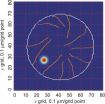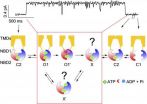(Press-News.org) Over millions of years, biological organisms – from the chameleon and cuttlefish to the octopus and squid – have developed color-changing abilities for adaptive concealment (e.g., camouflage) and communication signaling (e.g., warning or mating cues).
Over the past two decades, humans have begun to develop sophisticated e-Paper technology in electronic devices that reflect and draw upon the ambient light around you to create multiple colors, contrast and diffusion to communicate text and images.
And given the more than 100 million years head start that evolution has provided to these animals and their cellular systems, it's not surprising that e-Paper devices lag behind in optical performance, especially color generation.
In an effort to close that gap, a multidisciplinary team led by University of Cincinnati researchers is out today with a paper that aims to help biologists who work with these color-changing creatures and engineers who work with e-Paper technology. The paper – "Biological vs. Electronic Adaptive Coloration: How Can One Inform the Other?" – is in the "The Journal of The Royal Society Interface" (electronic version) and will be featured on the cover of the upcoming print issue.
Authors are Eric Kreit, a recent doctoral graduate in UC's College of Engineering and Applied Science (CEAS); Lydia M. Mäthger and Roger T. Hanlon, research scientists at the Marine Biological Laboratory in Woods Hole, Mass.; Patrick B. Dennis and Rajesh R. Naik, scientists at the Materials and Manufacturing Directorate, Air Force Research Laboratory, Wright Patterson Air Force Base; Eric Forsythe, scientist at the Army Research Laboratory; and Jason Heikenfeld, associate professor of electronic and computing systems, also in the University of Cincinnati's College of Engineering and Applied Science (CEAS).
According to UC's Kreit, "Our main goals were threefold: To allow display engineers to learn from millions of years of natural selection and evolution. To teach biologists the most advanced mechanisms and performance measurements used in human-made reflective e-Paper and to give all scientists a clearer picture of the long-term prospects for capabilities such as adaptive concealment and what can be learned from now you see me, now you don't mechanisms."
WAYS IN WHICH ANIMALS AND ELECTRONICS ARE ALIKE
One of the researchers' key findings is that there are numerous approaches to change the reflective color of a surface and that the highest-performance approaches developed by both humans and nature share some powerful common features. Both use pigment, and both change or achieve color expression by either spreading or compacting that pigment. Animals use muscle fiber to spread or compact pigment, and electronics make use of an electric field to do so.
However, even if the basic approach for color change is similar, humanity has never developed anything as complex or sophisticated as the biology and physics of cephalopod skin. (Cephalopods are a diverse ocean group and include 700 species of cuttlefish, squid and octopus – and are the acknowledged masters of color change on the planet).
According to Heikenfeld, "The highest performance human-made approaches have been only recently developed, well after numerous other approaches were tried. Perhaps in the past, if we had more closely trusted nature's ability to find the best solution, we would be further along today in creating better display technology."
ANIMALS ARE EFFICIENT USERS OF AVAILABLE LIGHT
Biological organisms that change color are very efficient at using available light. The animal's skin either reflects light to achieve a bright-color effect or absorbs light to achieve stunning, multi-colored effects.
In their use of available light, the biological organisms are more efficient than electronic devices, which generally require large amounts of electric power to generate an internal/emissive light to generate bright color.
Said Roger Hanlon, "Cephalopod skin is exquisitely beautiful and radiant, and can be changed in milliseconds, all without generating any intrinsic light from within the skin; there are elegant solutions from biology waiting to be translated to our consumer and industrial world."
In fact, overall, animals "outscore" synthetic devices when it comes to sophistication and integrated systems; required energy use for color change; size scalability (cephalopods' adaptive coloration works over a wide range of sizes in the organisms' class – from small-size cuttlefish to large-size octopus and squid); and surface texture (cephalopods can selectively adapt or "crinkle" their skins to match a variety of three-dimensional textures, which provides additional light scattering and shadowing).
ELECTRONIC DEVICES ACHIEVE COLORS FASTER AND ACHIEVE MORE COLORS
Human-developed technology is far superior to cephalopods or other color-adapting animals when it comes to speed. In other words, human-made electronics can achieve color and a color change faster than the response time of a biological organism.
In addition, synthetic devices can provide a greater range of colors and more efficient dark or black state. In other words, a device can achieve a black screen, but most biological organisms cannot achieve such darkened coloring. This is, in part, due to the fact that an organism like a marine animal generally has no reason, in terms of survival adaptation or signaling, to go to a dark or black state. Such an adaptation would actually make them more visible, not less, to predators.
INFORMATION:
FUNDING
This research was funded by the Air Force Research Laboratory, National Science Foundation, Air Force Office of Scientific Research, Army Research Laboratory, Defense Advanced Research Projects Agency and the Office of Naval Research.
How is a Kindle like a cuttlefish
2012-09-26
ELSE PRESS RELEASES FROM THIS DATE:
Reducing acrylamide levels in french fries
2012-09-26
The process for preparing frozen, par-fried potato strips — distributed to some food outlets for making french fries — can influence the formation of acrylamide in the fries that people eat, a new study has found. Published in ACS' Journal of Agricultural and Food Chemistry, the study identifies potential ways of reducing levels of acrylamide, which the National Toxicology Program and the International Agency for Research on Cancer regard as a "probable human carcinogen."
Acrylamide forms naturally during the cooking of many food products. Donald S. Mottram and colleagues ...
Preserving large females could prevent overfishing of Atlantic cod
2012-09-26
Cod are among Sweden's most common and most popular edible fish and have been fished hard for many years. One consequence is the risk of serious changes in cod stocks, reveals research from the University of Gothenburg, Sweden.
In overfished areas, there is often a shortage of large and old cod, and the fish become sexually mature at a younger age. Researchers have feared that this change may have impacted on the fish's health, physiological ageing and reproductive capacity.
In a recently published study, a research group from the University of Gothenburg working with ...
Date palm juice: A potential new 'green' anti-corrosion agent for aerospace industry
2012-09-26
The search for a "greener" way to prevent corrosion on the kind of aluminum used in jetliners, cars and other products has led scientists to an unlikely source, according to a report in ACS' journal Industrial & Engineering Chemistry Research. It's the juice of the date palm — those tall, majestic trees that, until now, were noted mainly as sources of food and traditional medicines.
Husnu Gerengi points out that strong, lightweight aluminum alloys are used to make planes, cars and industrial equipment. Aluminum corrodes when exposed to air, but unlike rusting steel, the ...
Study looks at risk factors for HIV in US Navy and Marines during 'Don't Ask, Don't Tell'
2012-09-26
Philadelphia, Pa. (September 26, 2012) – Same-sex partners and inconsistent condom use were among the major risk factors for HIV infection among U.S. Navy and Marines personnel during the "Don't Ask, Don't Tell" (DADT) era, reports a study in the October 1 issue of JAIDS: Journal of Acquired Immune Deficiency Syndromes. The journal is published by Lippincott Williams & Wilkins, a part of Wolters Kluwer Health.
"[M]ale-to-male sexual contact was a much more common mode of infection than previously reported," reports the new study, led by Shilpa Hakre, DrPH, MPH, of the ...
Researchers develop blood test that accurately detects early stages of lung, breast cancer in humans
2012-09-26
MANHATTAN, Kan. -- Researchers at Kansas State University have developed a simple blood test that can accurately detect the beginning stages of cancer.
In less than an hour, the test can detect breast cancer and non-small cell lung cancer -- the most common type of lung cancer -- before symptoms like coughing and weight loss start. The researchers anticipate testing for the early stages of pancreatic cancer shortly.
The test was developed by Stefan Bossmann, professor of chemistry, and Deryl Troyer, professor of anatomy and physiology. Both are also researchers affiliated ...
A birth control pill for men? When?
2012-09-26
When will men have their own birth control pill? Scientists have been predicting the debut of a male pill within 5 years for the last 30 years. The factors accounting for that delay — and new optimism that a male pill will emerge within a decade — are the topic of a story in the current edition of Chemical & Engineering News. C&EN is the weekly newsmagazine of the American Chemical Society, the world's largest scientific society.
In the story, Michael M. Torrice, C&EN associate editor, describes the need for a male version of the oral contraceptive pill that revolutionized ...
Loss of species makes nature more sensitive to climate change
2012-09-26
High biodiversity acts as an insurance policy for nature and society alike as it increases the likelihood that at least some species will be sufficiently resilient to sustain important functions such as water purification and crop pollination in a changing environment.
"It's the same principle as an investment portfolio – you'd be mad to put all your eggs in one basket," says researcher Johan Eklöf.
Experiments with eelgrass meadows in shallow inlets on the west coast of Sweden are now showing that climate change can exacerbate the negative effects of losing sensitive ...
Geometry plays a role in GPCR transmembrane signaling
2012-09-26
A recent study in The Journal of General Physiology characterizes the movement of rhodopsin, a GPCR and member of a large family of transmembrane receptors responsible for many cellular responses and involved in many human diseases.
In living Xenopus rod photoreceptor cells, rhodopsin is found in stacks of disc membranes that are difficult to study due to their small size. Now, Peter Calvert (SUNY Upstate Medical University) and colleagues have developed an approach with two-photon microscopy that, for the first time, allows direct examination within the living cell ...
University of Kentucky research sheds light on pain pill abuse
2012-09-26
LEXINGTON, Ky. (Sept. 26, 2012) — A study by a team of University of Kentucky researchers has shed new light on the potential habit-forming properties of the popular pain medication tramadol, in research funded by the National Institute on Drug Abuse. The paper is slated to appear in an upcoming edition of the academic journal Psychopharmacology.
Prescription pain killer abuse is a major public health problem in the U.S. In 2010, more individuals over the age of 12 reported nonmedical use of prescription pain relievers in the past month than use of cocaine, methamphetamine ...
New insights into functionality of cystic fibrosis protein
2012-09-26
CFTR is an important protein that, when mutated, causes the life-threatening genetic disease cystic fibrosis. A study in The Journal of General Physiology (JGP) details how an accidental discovery has provided new understanding about CFTR functionality.
From a scientific standpoint, CFTR is unique in that it is the only known ion channel—a protein pore that enables the passive diffusion of ions across cell membranes—in the enormous superfamily of ABC proteins, which normally operate as active transporters. As active transporters, ABC proteins use energy derived from ...


